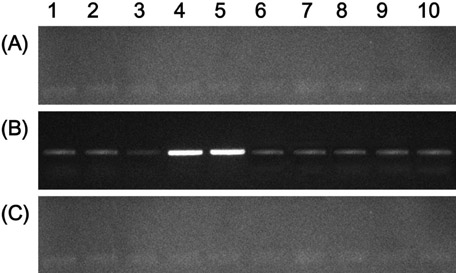Lab Anim Res.
2012 Sep;28(3):193-197. 10.5625/lar.2012.28.3.193.
Anticoccidial effects of Galla rhois extract on Eimeria tenella-infected chicken
- Affiliations
-
- 1Korean Medicine (KM)-Based Herbal Drug Research Group, Korea Institute of Oriental Medicine, Dajeon, Korea.
- 2Center for Animal Resources Development, Wonkwang University, Iksan, Korea. kimoj@wku.ac.kr
- 3Institute of Animal Experiment & Efficacy Evaluation, Wonkwang University, Iksan, Korea.
- 4Department of Companion Animal and Animal Resources Science, Joongbu University, Geumsan, Korea.
- 5Center for Agricultural Biomaterials, Seoul National University, Seoul, Korea.
- 6Digestive Disease Research Institute, Wonkwang University, Iksan, Korea.
- KMID: 1436724
- DOI: http://doi.org/10.5625/lar.2012.28.3.193
Abstract
- Anticoccidial effects of Galla rhois (GR) extract were evaluated in chickens after oral infection with Eimeria tenella. This study was performed using 3-day-old chickens (n=30). The animals were divided into 3 groups as follows: GR 0.5%/infected (n=10), untreated/infected (n=10), and non-infected control (n=10). The chickens were fed a standard diet supplemented with or without GR for 1 week before infection with E. tenella (10,000 sporulated oocysts per chicken). The effects of GR on E. tenella infection were assessed by 2 parameters, number of fecal oocysts and body weight gain, and the results of the polymerase chain reaction (PCR). The GR-fed chickens produced significantly lower number of fecal oocysts (P<0.05) than the E. tenella-infected chickens who were fed the standard diet. In addition, GR-based diet improved the loss of body weight caused by E. tenella infection. Positive findings of PCR were identified by distinct bands in the samples of E. tenella-inoculated chickens. However, PCR analysis revealed no E. tenella oocysts in the feces of GR-fed chickens. Our data showed that GR extracts had remarkable anticoccidial activities against E. tenella. This finding might have implications for the development of novel anticoccidial drugs.
MeSH Terms
Figure
Reference
-
1. Dalloul RA, Lillehoj HS. Poultry coccidiosis: recent advancements in control measures and vaccine development. Expert Rev Vaccines. 2006. 5(1):143–163.2. Wilson PA, Fairbairn D. Biochemistry of sporulation in oocysts of Eimeria acervulina. J Protozool. 1961. 8(4):410–416.3. Dalloul RA, Lillehoj HS. Recent advances in immunomodulation and vaccination strategies against coccidiosis. Avian Dis. 2005. 49(1):1–8.4. Min W, Dalloul RA, Lillehoj HS. Application of biotechnological tools for coccidia vaccine development. J Vet Sci. 2004. 5(4):279–288.5. Allen PC, Fetterer RH. Recent advances in biology and immunobiology of Eimeria species and in diagnosis and control of infection with these coccidian parasites of poultry. Clin Microbiol Rev. 2002. 15(1):58–65.6. Chapman HD. Biochemical, genetic and applied aspects of drug resistance in Eimeria parasites of the fowl. Avian Pathol. 1997. 26(2):221–244.7. Williams RB. Fifty years of anticoccidial vaccines for poultry (1952-2002). Avian Dis. 2002. 46(4):775–802.8. Hong SH, Song J, Son MW, Kim O. The effects of natural herbal antibacterial compound against enteropathogenic Escherichia coli. Lab Anim Res. 2008. 24(3):341–346.9. Lee HA, Park H, Kim YC, Kim O. The effects of natural herbal antiviral compound against porcine epidemic diarrhea virus. Lab Anim Res. 2008. 24(2):179–185.10. Lee HA, Hwang KK, Song JH, Kim O. The effects of an herbal antimicrobial feed additive on the health status and performance of growing and finishing pigs. Lab Anim Res. 2008. 24(2):187–192.11. An RB, Oh H, Kim YC. Phenolic constituents of galla Rhois with hepatoprotective effects on tacrine- and nitrofurantoin-induced cytotoxicity in Hep G2 cells. Biol Pharm Bull. 2005. 28(11):2155–2157.12. Choi JG, Kang OH, Lee YS, Oh YC, Chae HS, Jang HJ, Shin DW, Kwon DY. Antibacterial activity of methyl gallate isolated from Galla Rhois or carvacrol combined with nalidixic acid against nalidixic acid resistant bacteria. Molecules. 2009. 14(5):1773–1780.13. Lee HA, Hong S, Chung Y, Kim O. Sensitive and specific identification by polymerase chain reaction of Eimeria tenella and Eimeria maxima, important protozoan pathogens in laboratory avian facilities. Lab Anim Res. 2011. 27(3):255–258.14. McDougald LR. Saif YM, Barnes HJ, Glisson JR, Fadly AM, McDougald LR, Swayne DE, editors. Protozoal infections. Diseases of Poultry. 2003. Ames: Iowa State Press;973–991.15. Stotish RL, Wang CC, Meyenhofer M. Structure and composition of the oocyst wall of Eimeria tenella. J Parasitol. 1978. 64(6):1074–1081.16. Chapman HD, Matsler PL, Muthavarapu VK, Chapman ME. Acquisition of immunity to Eimeria maxima in newly hatched chickens given 100 oocysts. Avian Dis. 2005. 49(3):426–429.17. Min W, Lillehoj HS, Burnside J, Weining KC, Staeheli P, Zhu JJ. Adjuvant effects of IL-1beta, IL-2, IL-8, IL-15, IFN-alpha, IFN-gamma TGF-beta4 and lymphotactin on DNA vaccination against Eimeria acervulina. Vaccine. 2001. 20(1-2):267–274.
- Full Text Links
- Actions
-
Cited
- CITED
-
- Close
- Share
- Similar articles
-
- Anticoccidial effects of the Plantago asiatica extract on experimental Eimeria tenella infection
- Anticoccidial effects of the Houttuynia cordata extract on experimental animal infection model
- Anticoccidial effects of the root bark of Dictamnus dasycarpus Turcz extract on experimental Eimeria tenella infection
- Anticoccidial Activity of Berberine against Eimeria-Infected Chickens
- Anti-coccidial activity of the ethanol extract of Tribulus terrestris fruits on Eimeria tenella


